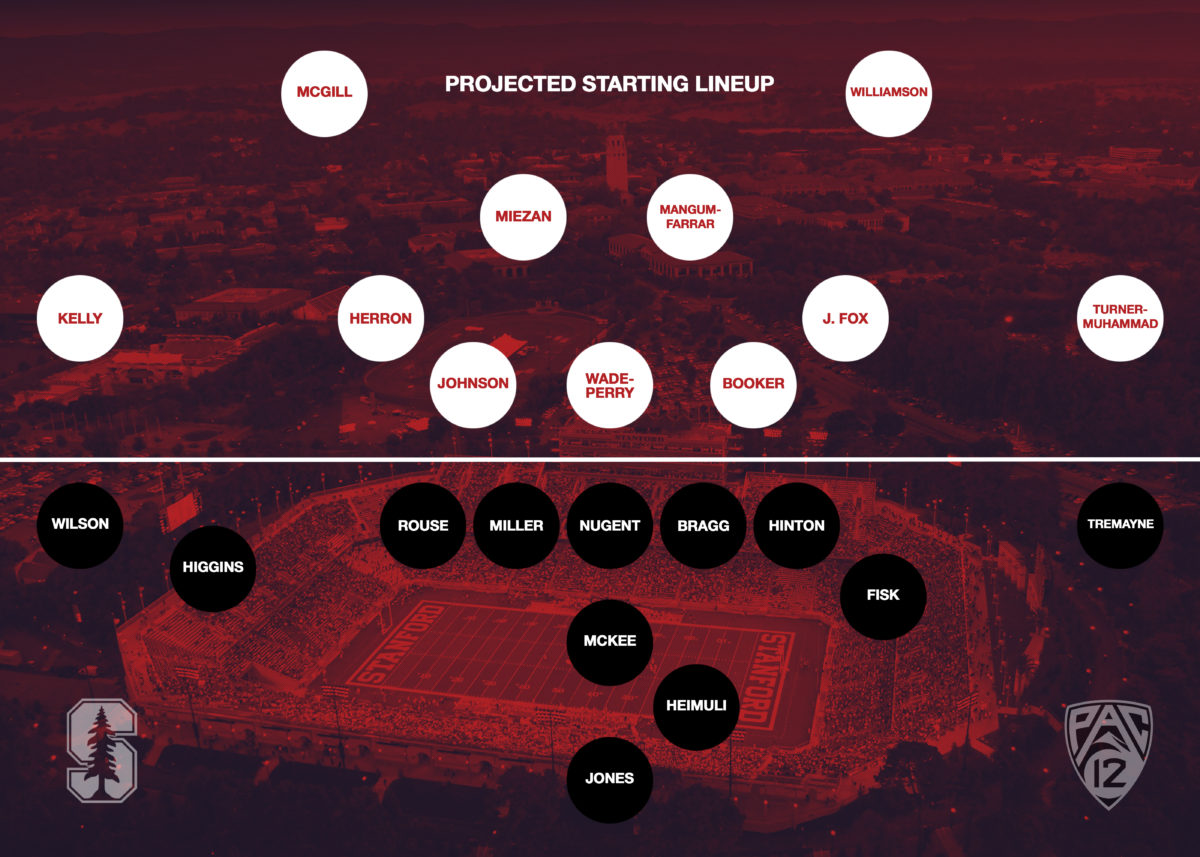In late November 2020, the Stanford football team faced yet another challenge during a very unusual year. Santa Clara County prohibited contact sports, preventing Stanford from practicing or hosting games on campus. As the team scrambled to find sites to practice, they ended up practicing in a public park in Washington, as well as on the side of the road in Corvallis, Oregon. Junior offensive tackle Walter Rouse ’23 remembers the experience on the Oregon State trip.
“We’re literally lifting on the side of the road … and I’m just really thinking, ‘How did we even get to this point?’ and, ‘What are we even doing here?’” Rouse said. “But we took what came at us and dealt with it.”
Dealt with it they did, rattling off four straight road wins to close the season after a 0-2 start, despite not being allowed to partake in activities in their home county for the prior three weeks.
But there’s even more to the story. Four Cardinal players, including starting quarterback Davis Mills ’21, were ruled out of the opener due to what ended up being a false-positive COVID-19 test. They were not cleared to play until the Friday before Week 2, giving them only one day of practice before hosting Colorado.
All throughout the offseason, people have attempted to undercut Oregon’s second straight Pac-12 title by pointing to Washington’s end-of-season COVID-19 debacle that forced them to be replaced in the conference championship game — meanwhile, Stanford’s false positive is scarcely mentioned. Anyone who watched Stanford fall to Colorado in Week 2 saw an offense that struggled mightily early but found its groove as the game progressed. We’d be remiss not to mention that the defense was atrocious in that 35-32 loss, but we’re also quite confident that Stanford wins if Mills practices all week. We will never know what would have happened, but one sure can make a compelling argument that Stanford would have won the Pac-12 North if not for that false positive. But the past is the past, and the focus now shifts to how the Cardinal can use last year’s experience to succeed in the future.
A common theme amongst the team is resilience. As sixth-year outside linebacker Jordan Fox put it, “Having that last year, going 4-2 from that, being kicked out of our own state and going to practice on the road, we know what it’s gonna take, and we’re ready for any challenge that comes at us this year.”
“When we face a challenge, if we have a setback, we’ll be resilient,” Fox said. “We know what it takes to do it because we did it before. We have that maturity.”
With last year’s growth combined with the prospect of playing a full season with fans in the stands, you already have an excited group of guys. The media’s doubt of the Cardinal this season and tendency to dismiss last year’s 4-2 record as lucky add to that motivation.
The sentiment around the squad is one of excitement.
“We have some semblance of a regular camp heading into the new season. I cannot wait to play, and if you ask anyone else on this team, they’re going to say the same thing,” Rouse said. “A lot of that excitement also stems from the fact that people doubt us — we cannot wait to prove them wrong, and we cannot wait to just do what Stanford football does.”
Challenging year ahead
Despite a lack of confidence from other analysts, we have the Cardinal going 7-5 overall and 5-4 in the conference, stats which should be good for a third-place finish in the North division, behind Oregon and Washington. This would render the Cardinal bowl game eligible after a 10-year streak was broken by the 4-8 season in 2019.
Becoming bowl-eligible, however, will not be easy. There are two ways to look at the team’s brutal, all-Power 5 schedule featuring six teams in the preseason top-25. One way is that the Cardinal are hurting themselves — as a program that has precipitously fallen from national relevance over the last few years, one could argue that the Cardinal should have padded their record to make bowl-eligibility much easier.
On the other hand, another could say that this schedule gives the Cardinal a chance to prove they are truly back if they go, say, 9-3 against such a grueling slate. It’s important to remember that these games are scheduled years in advance, so it can be difficult to predict just how difficult one’s schedule will be in a given year. With that said, we would have preferred to see a brand-new starter face FCS opposition Week 1, instead of Power 5 opponent Kansas State.
Many would find our 7-5 prediction a bit generous. After all, Vegas has the Cardinal sitting at four wins. They were also picked fourth in the preseason Pac-12 media poll and are absent from most bowl projections. But a 7-5 prediction is not generous. Look at Stanford’s last four recruiting classes: No. 40 in 2018, No. 19 in 2019, No. 21 in 2020 and No. 41 in 2021. Even with such a tough schedule, that’s not a four-win team on paper.
People have raised endless questions about the defense, but eight starters are back, and that’s not counting the return of physically healthy seniors Ricky Miezan and Jacob Mangum-Farrar. Add them to everyone getting a year older and stronger — if Booker stays off the injured list, this group is at worst average in the Pac-12.
On the offense, all the talk has been about how the Cardinal will have a tough time replacing Davis Mills ’21, Simi Fehoko, Drew Dalman ’21 and Foster Sarell ’21. But there are answers to those questions: Stanford has a deep wide receiver, running back and offensive line group, and while sophomore Tanner McKee in Year 1 might not be as good as Mills, there’s no reason why McKee can’t be an above-average quarterback in the conference.

Vaccination update
As of Coach David Shaw’s Aug. 25 press conference, 85% of the program has been vaccinated. While Stanford is requiring the vaccine for students to come to campus this fall, waiver exemptions for medical and religious reasons can be granted.
Around the Pac-12, seven schools have achieved 90% vaccination rates, while one other school joins the Cardinal at 85%. UCLA comes in with the highest rate at 98% program-wide. Washington State brings up the rear at 80%.
Bottom line
This all leads us to the theme of Stanford football this season: all the potential issues have clear solutions that will more likely than not work out. There are obvious positions that must be replaced, areas that need improvement — while it’s unlikely that every single one of these solutions will pan out, the majority will, and it should get the Cardinal back to bowl eligibility. That said, Stanford is missing out on facing Colorado and Arizona, substantially hurting their chances to compete for the division title. It’s also hard to argue that Stanford is better on paper than Oregon or Washington this season.
In addition to the play on the field, much has been made of Shaw’s recent recruiting efforts. The 2021 class of current freshmen came in at No. 41 in the country and No. 7 in the Pac-12, according to 247Sports. This mark is Stanford’s lowest since 2013, and would have been even lower if it were not for the late-June commitment and reclassification of highly rated outside linebacker Wilfredo Aybar. Nevertheless, this trend does not seem like one that will continue — the 2022 class currently sits in the top-20 in the country and second in the conference, with 16 verbal commitments and four months to go until the Early National Signing Period.
The return of on-campus visits has played a pivotal role for the coaching staff, as the NCAA did not allow such visits from March 2020 through May 2021. Staying in that top-25 range is key for Stanford football to stay relevant both in the Pac-12 and on the national stage. To reel in those top prospects, though, the Cardinal need to get back to their pre-2019 standard. Today’s recruits were too young to have grown up watching Andrew Luck ’12, Toby Gerhart ’10 and Kevin Hogan ’16 lead Stanford to big wins in the Orange Bowl and Rose Bowl, and future generations of Cardinal football have to give top recruits more reasons for excitement.
All in all, this 2021 squad is good enough to get the program back on the right track, with the expansion of the College Football Playoff on the horizon. Playoff expansion gives Stanford the ability to get back to that elite level — that is, if the program can put itself in a position in which they can tell recruits they are a conference championship away from competing on the biggest stage in college football, the talent level in this program can go up a notch. Add that to a recruit having every opportunity to play professionally, being able to live in beautiful Palo Alto and getting the best education of any FBS school, and the appeal of attending Stanford would be at an all-time high. But they have to demonstrate that a Pac-12 championship is attainable. They have to get back to that eight- or nine-win base to show that Oregon and USC are not leaving them in the dust, as the national media portrays. With a brutal schedule this year and a team that should see a lot of returning production in 2022, a winning season in 2021 would be a step in the right direction.
For a more detailed preview of the season, check out the position breakdown here.
